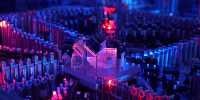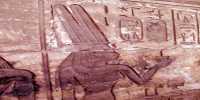In CE 97, a beautiful set of dry scrolls was set up in a private library near the coast, as hell rained down on Pompeii and Herculaneum at the foot of Mount Vesuvius. In addition to most cities and their people, the scrolls were carbonized by the eruption of hot volcanic debris and they fit into broken carbon holes that break very easily.
Scientists at the University of Kentucky have hired Diamond Light Source, a synchrotron light source science facility in the UK, to explode carbonated scrolls with high-energy X-rays to capture subtle hints of invisible ink on the naked eye. They will then use artificial intelligence to “fill in the blanks”. Now, almost 2,000 years later, a group of researchers says they finally have the technology to understand the papyrus text.
“First, we can immediately define the internal structure of the scrolls as much as possible, and we need that level of detail to get the text out of the high-level compressed layer. “We don’t expect to see the text immediately from upcoming scans, but they will provide important building blocks to enable this scenario,” Professor Brent Seales, director of digital recovery initiatives at the University of Kentucky, explained in a statement.
“The machine-learning tool we’re developing will amplify that ink signal by training computer algorithms – pixel by pixel – to identify where the ink is from images of blank segments – voxel outside the voxel – related tomographic data,” he added. Collectively known as Herculaneum papyrus, the texts are considered from archeology to be the only surviving library that exists in its entirety. The books that have been successfully studied contain works of a philosophical nature that provide an interesting insight into the world of the Roman Empire. These
special scrolls, consisting of two complete scrolls and four pieces, were found in 1752 in the vicinity of the Roman Villa ruins near the Gulf of Naples, along with thousands of other papyri. Many of these scrolls are tightly closed and impossible
to read in their current state. Attempts have been made to physically open a handful of closed Herculaneum scrolls, but researchers say they have been “mostly destructive.” As such, many texts remain untouched and their knowledge unknown.
Judging by the team and technology being used like this time, the scrolls are safely at hand. Leading the work, computer scientist Professor Siles was previously involved in attempts to use imaging techniques in all types of ancient documents, including the first available copy of the Old Testament Bible, the N-Gaddy Scroll.















